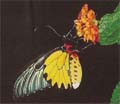|
|
|
Scientific name Troides aeacus formosanus (Rothschild, 1899)
= Troides aeacus kaguya Nakahara & Esaki, 1930
|
|
Chinese name 黃裳鳳蝶、恆春金鳳蝶
|
|
English name
Small Birdwing, Dwarf Birdwing, Heng-chun Birdwing Butterfly |
|
Classification 鳳蝶科(Papilionidae),鳳蝶亞科(Papilioninae),裳鳳蝶族(Troidini)
|
|
Diagnosis
Large-sized swallowtail species. Forewing span 13-20 cm.
Head and thorax black. Lateral sides of thorax with red
hairs. Abdomen brightly yellow with black dots. Terminal
adbominal segment of male grayish white. Colouration similar
to the former species, but lacking of pearly reflection
on the hindwings. |
|
Distribution
The whole species is widely ranging throughout the eastern
Asia. The nominotypical T. a. aeacus Felder ranges from
S. China, most parts of the Indochinese Peninsula to the
N.E. India. T. a. szechwanus O. & O. is distributed
to the C., S.W. and E. China. T. a. malaiianus Fruhstorfer
is confined to the Malayan Peninsula, and the little known
T. a. insularis Ney is restricted to Sumatra. T. a. formosanus
inhabits in the coastal forests of lowland and as well
in the temperate forests at around 2000 m. The records
reported from some localities might be captive individuals
escaped from butterfly breeders. Currently, several stray
individuals were found in the Yayeyama Archipelago of
Japan. |
|
Habitat and Ecology
According to Chang & Tzai (1984), this species has
two peaks of activity during March-April and July-August,
and even during the winter. The larvae feed on most species
of Aristolochia spp. found or invaded to Taiwan. The adults
soar in the sky or canopy in the early moring and late
afternoon and visit various families of plants as nectar
sources. The females prefer to fly slowly in the forests.
The eggs are laid singly under the leaves and the larvae
are more common in the top layer of hosts. Either younger
or mature larvae bear many protuberances along the body
and have whitish red band on the third abdominal segment
which extends to the fourth abdominal segment. Pupation
occurs in bushes or the surroundings of host. The pupae
have thoracic horn-like processes and dorsal abdominal
horns. The confirmed hostplants in Taiwan are Aristolochia
heterophylla (Hsu, 1999), A. zollingeriana (Tsai, 1985,
1987; Lee & Chang, 1988; Lin, 1994; Hsu, 1999) and
other native Aristolochia species. According to Hsu (1999),
A. elegans was also utilized by the larvae when the plant
was introduced in 1980s, but currently it has been observed
that this plant is refused. |
|
Threats and Conservation Status
This subspecies in Taiwan was severely threatened by commercial
collecting and habitat loss since 1950s. However, since
certain habitats have been well preserved in the Kenting
National Park and some other Nature Reserves in S. Taiwan,
this subspecies seems not very rare now and has extended
their geographical range to Lutao since 1970s and established
some populations in C. and N.E. Taiwan. For information
about conservation of this subspecies see Ho & Chang
(1997). |
|
Remarks
In this book, we adopt the viewpoint of Haugum & Low
(1985), who revalidated the subspecific name "formosana
Rothschild, 1899," and synonymized "kaguya Nakahara
& Esaki, 1930," a commonly used but unnecessary
replacement name. |
|
 |
|
|

Troides aeacus formosanus (Rothschild),
male, Kengting |

Troides aeacus formosanus (Rothschild),
female, Kengting |

Troides aeacus formosanus (Rothschild),
egg, Kengting |

Troides aeacus formosanus (Rothschild),
2nd instar larva,
Kengting |

Troides aeacus formosanus (Rothschild),
final instar larva,
Kengting |

Troides aeacus formosanus (Rothschild),
pupa, Kengting |
|
|
|